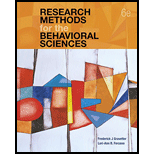
Concept explainers
Compare and contrast the nonscientific methods for knowing or acquiring knowledge (tenacity, intuition, authority, the rational method, and the empirical method). Identify an example and explain the limitations of each method.
Consider the following questions.
Does multitasking make you more efficient with your time?
Does having more friends make you less vulnerable to depression?
Are children of divorced parents less likely to be satisfied with their romantic relationships?
Are girls more likely to cyberbully than boys?
Does eating cake for breakfast make dieters more likely to stick to their diets later in the day?
Are adolescents who play violent video games more aggressive than adolescents who do not play violent video games?
Does playing brain games in adulthood make it less likely you will develop Alzheimer’s?
Compare and differentiate the non-scientific methods for acquiring knowledge. Identify an example and explain the limitation of each method.
Answer to Problem 1LO
Solution:
Scientific method means a stepped and logically fixed process for acquiring knowledge and understanding knowledge. The method of acquiring knowledge which is not scientific is termed as non-scientific.
Explanation of Solution
The non-scientific method does not have logically set procedures. The non-scientific ways of obtaining knowledge are explained as under -
- Tenacity:
- Intuition:
- Authority:
- Rational Method:
- Empirical Method:
Tenacity means what has been true in the past holds firmly to the belief and is expressed as "it has always been so".
Intuition means that something which just stands to reason. It involves use of rational processes with the experience benefit.
Authority means the process of established belief based on the prominent source.
It states that truth is intellectual. The process of rational decision making involves the consideration to all factors which are affected.
It is a method wherein knowledge is acquired through one's own experience and learning.
Example of non-scientific method to acquire knowledge is the speeches of the politicians − Authority.
Limitations of each method:
- Tenacity:
- Intuition:
- Authority:
- Rational Method:
- Empirical Method:
It does not support evaluation.
It means belief from within. Belief is unsupported by objective evidences.
The established belief on which it is based may be wrong.
It can construct logical arguments for both sides of debate. Hence, it cannot be completely relied upon.
While using this method, it is difficult to be an objective observer.
Want to see more full solutions like this?
Chapter 1 Solutions
Research Methods for the Behavioral Sciences (MindTap Course List)
Additional Math Textbook Solutions
Elementary Statistics (13th Edition)
Basic Business Statistics, Student Value Edition
Algebra and Trigonometry (6th Edition)
Elementary and Intermediate Algebra: Concepts and Applications (7th Edition)
Elementary Statistics: Picturing the World (7th Edition)
Probability And Statistical Inference (10th Edition)
- A marketing agency wants to determine whether different advertising platforms generate significantly different levels of customer engagement. The agency measures the average number of daily clicks on ads for three platforms: Social Media, Search Engines, and Email Campaigns. The agency collects data on daily clicks for each platform over a 10-day period and wants to test whether there is a statistically significant difference in the mean number of daily clicks among these platforms. Conduct ANOVA test. You can provide your answer by inserting a text box and the answer must include: also please provide a step by on getting the answers in excel Null hypothesis, Alternative hypothesis, Show answer (output table/summary table), and Conclusion based on the P value.arrow_forwardA company found that the daily sales revenue of its flagship product follows a normal distribution with a mean of $4500 and a standard deviation of $450. The company defines a "high-sales day" that is, any day with sales exceeding $4800. please provide a step by step on how to get the answers Q: What percentage of days can the company expect to have "high-sales days" or sales greater than $4800? Q: What is the sales revenue threshold for the bottom 10% of days? (please note that 10% refers to the probability/area under bell curve towards the lower tail of bell curve) Provide answers in the yellow cellsarrow_forwardBusiness Discussarrow_forward
- The following data represent total ventilation measured in liters of air per minute per square meter of body area for two independent (and randomly chosen) samples. Analyze these data using the appropriate non-parametric hypothesis testarrow_forwardeach column represents before & after measurements on the same individual. Analyze with the appropriate non-parametric hypothesis test for a paired design.arrow_forwardShould you be confident in applying your regression equation to estimate the heart rate of a python at 35°C? Why or why not?arrow_forward
 Glencoe Algebra 1, Student Edition, 9780079039897...AlgebraISBN:9780079039897Author:CarterPublisher:McGraw Hill
Glencoe Algebra 1, Student Edition, 9780079039897...AlgebraISBN:9780079039897Author:CarterPublisher:McGraw Hill Holt Mcdougal Larson Pre-algebra: Student Edition...AlgebraISBN:9780547587776Author:HOLT MCDOUGALPublisher:HOLT MCDOUGAL
Holt Mcdougal Larson Pre-algebra: Student Edition...AlgebraISBN:9780547587776Author:HOLT MCDOUGALPublisher:HOLT MCDOUGAL Big Ideas Math A Bridge To Success Algebra 1: Stu...AlgebraISBN:9781680331141Author:HOUGHTON MIFFLIN HARCOURTPublisher:Houghton Mifflin Harcourt
Big Ideas Math A Bridge To Success Algebra 1: Stu...AlgebraISBN:9781680331141Author:HOUGHTON MIFFLIN HARCOURTPublisher:Houghton Mifflin Harcourt
 Linear Algebra: A Modern IntroductionAlgebraISBN:9781285463247Author:David PoolePublisher:Cengage Learning
Linear Algebra: A Modern IntroductionAlgebraISBN:9781285463247Author:David PoolePublisher:Cengage Learning




